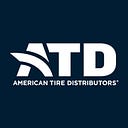Tires 101: The Structure of a Tire
American Tire Distributors (ATD) is one of the largest independent suppliers of tires to the replacement tire market. We operate more than 140 distribution centers, including 25 distribution centers in Canada, serving approximately 80,000 customers across the U.S. and Canada. With more than 80 years of experience, we know a thing or two about tires and we want you to be safe every time you get behind the wheel.
Tires can be intimidating because there are so many different types. We helped you understand them in our Tires 101: Understanding the Many Types of Tires blog and now, we’ll help you understand the structure of a tire. These components make up the skeleton of a tire and are what hold it together so you’re able to get the most out of them.
- Rubber/Inner Liner: The Rubber/Inner Liner of a tire substitutes for the tube in the tire’s interior and consists of a rubber layer with low air permeability. The main function of the liner is to hold high-pressure air inside.
- Carcass Ply: This Carcass Ply is the framework that refers to all of the layers that make up the tire cord, which is comprised of thin textile fiber cables that are bonded into the rubber. This absorbs the tire’s internal air pressure, weight and shock.
- Bead: The Bead wraps around the end of the cord and fastens the tire to the rim. The rim is slightly tightened so in the case of a sudden reduction of air pressure, the tire will not become unfastened from the rim and fall off.
- Sidewall: The Sidewall is located between the shoulder and bead of the tire and it provides protection to the carcass. The Sidewall is marked with detailed information about the tire, which you can click here to read our previous Tires 101 blog, How to Read a Tire Sidewall.
- Crown Piles: The Crown Piles provides the rigid base for the tread. The plies also provides a centrifugal and lateral rigidity to the tire, while also allowing the tire to flex sufficiently for a comfortable ride.
- Tread: The Tread of the tire consists of a thick layer of rubber, which comes into direct contact with the road. This also provides protection to the inner layers of the tire. Tread can be designed in various patterns depending on the vehicle it’s meant to be used on and the conditions it’s meant to be driven in.
- Shoulder (located between the tread and sidewall): The Shoulder of the tire is the thickest part of a tire’s construction. This is designed to dissipate heat that accumulates inside the tire while driving and provide added support to strengthen the tire.
As tires range in various categories and sizes, the appearance of the tire changes. However, the anatomy stays the same. Next time you head to your local tire shop and the technician is referencing a part of the tire, you can better understand and have a visual representation to help guide you.
From your friends at ATD, we want you to be prepared for the road ahead so you can thrive and drive into the future. Follow along our Tires 101 blog as we explore the world of tires.
